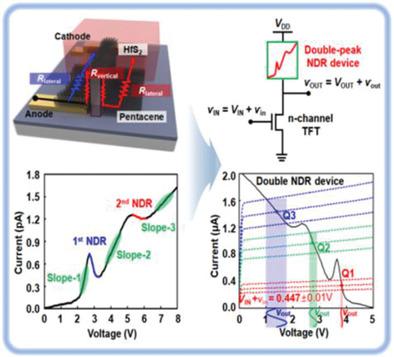Our official English website, www.x-mol.net, welcomes your feedback! (Note: you will need to create a separate account there.)
Double Negative Differential Resistance Device Based on Hafnium Disulfide/Pentacene Hybrid Structure
Advanced Science ( IF 15.1 ) Pub Date : 2020-08-05 , DOI: 10.1002/advs.202000991 Kil-Su Jung 1, 2 , Keun Heo 3 , Min-Je Kim 4 , Maksim Andreev 3 , Seunghwan Seo 3 , Jin-Ok Kim 3 , Ji-Hye Lim 3 , Kwan-Ho Kim 3 , Sungho Kim 5 , Ki Seok Kim 6, 7 , Geun Yong Yeom 7 , Jeong Ho Cho 8 , Jin-Hong Park 1, 3
Advanced Science ( IF 15.1 ) Pub Date : 2020-08-05 , DOI: 10.1002/advs.202000991 Kil-Su Jung 1, 2 , Keun Heo 3 , Min-Je Kim 4 , Maksim Andreev 3 , Seunghwan Seo 3 , Jin-Ok Kim 3 , Ji-Hye Lim 3 , Kwan-Ho Kim 3 , Sungho Kim 5 , Ki Seok Kim 6, 7 , Geun Yong Yeom 7 , Jeong Ho Cho 8 , Jin-Hong Park 1, 3
Affiliation

|
Recently, combinations of 2D van der Waals (2D vdW) materials and organic materials have attracted attention because they facilitate the formation of various heterojunctions with excellent interface quality owing to the absence of dangling bonds on their surface. In this work, a double negative differential resistance (D‐NDR) characteristic of a hybrid 2D vdW/organic tunneling device consisting of a hafnium disulfide/pentacene heterojunction and a 3D pentacene resistor is reported. This D‐NDR phenomenon is achieved by precisely controlling an NDR peak voltage with the pentacene resistor and then integrating two distinct NDR devices in parallel. Then, the operation of a controllable‐gain amplifier configured with the D‐NDR device and an n‐channel transistor is demonstrated using the Cadence Spectre simulation platform. The proposed D‐NDR device technology based on a hybrid 2D vdW/organic heterostructure provides a scientific foundation for various circuit applications that require the NDR phenomenon.
中文翻译:

基于二硫化铪/并五苯杂化结构的双负微分电阻器件
最近,2D范德华(2D vdW)材料和有机材料的组合引起了人们的关注,因为它们表面不存在悬挂键,有利于形成各种具有优异界面质量的异质结。在这项工作中,报告了由二硫化铪/并五苯异质结和 3D 并五苯电阻器组成的混合 2D vdW/有机隧道器件的双负微分电阻 (D-NDR) 特性。这种 D-NDR 现象是通过并五苯电阻器精确控制 NDR 峰值电压,然后并联集成两个不同的 NDR 器件来实现的。然后,使用 Cadence Spectre 仿真平台演示了由 D-NDR 器件和 n 沟道晶体管配置的可控增益放大器的运行情况。所提出的基于混合二维 vdW/有机异质结构的 D-NDR 器件技术为需要 NDR 现象的各种电路应用提供了科学基础。
更新日期:2020-10-07
中文翻译:

基于二硫化铪/并五苯杂化结构的双负微分电阻器件
最近,2D范德华(2D vdW)材料和有机材料的组合引起了人们的关注,因为它们表面不存在悬挂键,有利于形成各种具有优异界面质量的异质结。在这项工作中,报告了由二硫化铪/并五苯异质结和 3D 并五苯电阻器组成的混合 2D vdW/有机隧道器件的双负微分电阻 (D-NDR) 特性。这种 D-NDR 现象是通过并五苯电阻器精确控制 NDR 峰值电压,然后并联集成两个不同的 NDR 器件来实现的。然后,使用 Cadence Spectre 仿真平台演示了由 D-NDR 器件和 n 沟道晶体管配置的可控增益放大器的运行情况。所提出的基于混合二维 vdW/有机异质结构的 D-NDR 器件技术为需要 NDR 现象的各种电路应用提供了科学基础。


























 京公网安备 11010802027423号
京公网安备 11010802027423号